
Shravanabelagola is a town located near Channarayapatna of Hassan district in the Indian state of Karnataka and is 144 km (89 mi) from Bengaluru. The Gommateshwara Bahubali statue at Shravanabelagola is one of the most important tirthas in Jainism, one that reached a peak in architectural and sculptural activity under the patronage of Western Ganga dynasty of Talakad. Chandragupta Maurya is said to have died on the hill of Chandragiri, which is located in Shravanabelagola, in 298 BCE after he became a Jain monk and assumed an ascetic life style.

Chanderi, is a town of historical importance in Ashoknagar District of the state Madhya Pradesh in India. It is situated at a distance of 127 km from Shivpuri, 37 km from Lalitpur, 55 km from Ashok Nagar and about 46 km from Isagarh. It is surrounded by hills southwest of the Betwa River. Chanderi is surrounded by hills, lakes and forests and is spotted with several monuments of the Bundela Rajputs. It is famous for ancient Jain Temples. Its population in 2011 was 33,081.

Padmāvatī is the protective goddess or śāsana devī (शासनदेवी) of Pārśvanātha, the twenty-third Jain tīrthāṅkara, complimenting Parshwa yaksha in Swetambara and Dharanendra in digambar the shasan deva. She is a yakshini of Parshwanatha.

Humcha / Hombuja is a small town near Ripponpet, Hosanagara taluk in Shimoga district in the Indian state of Karnataka. Humbaja Atishaya Jain Teerth Kshetra is famous for being home to an ancient temple of Goddess Padmavati, and to the Humbaj Matha (seminary/monastery), an important institution of the Jain community. This temple is considered to be very holy and is known for its cultural and historical heritage. Other notable highlights of the place are a lake that reputedly never dries up and a tree that likewise always remains green.

Padampura or Bada Padampura is a Jain temple in Shivdaspura town in Jaipur district of Rajasthan. It is located at a distance of 35 km from Jaipur on Jaipur-Kota road.

Mangi-Tungi is a prominent twin-pinnacled peak and Digambar Jain Pilgrimage Site, located near Tahrabad about 125 km from Nashik, Maharashtra, India. Mangi, 4,343 ft (1,324 m) high above sea level, is the western pinnacle and Tungi, 4,366 ft (1,331 m) high, the eastern. Mangi-Tungi is 30 km (19 mi) from the city of Satana.
Narasimharajapura or NRpura is a town and taluk headquarter in Chikkmagaluru district, Karnataka, India. It is situated in the Malenadu region of the district. In 1915, Yuvaraja Shri Narasimharaja Wodeyar visited Yedehalli and in his memory, the town was named after him. The taluk was ruled by Ganga, Kadamba, Santhara, Hoysala and Vijayanagara kings.
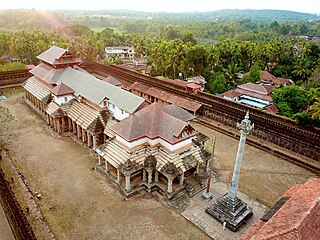
Moodubidire is a town and taluk in Dakshina Kannada district. It lies 34 km northeast of the district headquarters, Mangalore, in Karnataka, India.

Karnataka, a state in South India has a long association with Jainism, a religion which enjoyed patronage of major historic kingdoms in the state such as the Rastrakuta Dynasty, Western Ganga, Kadamba and Chalukya dynasties and the Hoysala Empire. Today the state is home to a number of Jain monuments, such as temples, Gommata statues and stambhas.
Temples of the Indian State of Karnataka illustrate the variety of architecture prevalent in various periods. The architectural designs have found a distinguished place in forming a true atmosphere of devotion for spiritual attainment.
Barnava is a village located in the Bagpat district of Uttar Pradesh, India. It is located between Sardhana and Binauli near Meerut. It is about 3 km from Binauli and 37 km from Meerut. In the Mahabharata, Baranava is mentioned as Varanāvata and is the site of the Lakshagraha. Many believe that Barnava still has evidence of Lakshagraha.

Jainism in North Karnataka flourished under the Chalukyas, Kadamba, Rashtrakutas, and Vijayanagara Empire. Imbued with religious feeling, patronage was extended towards the building of Jain temple and it garnered high repute among the people, particularly the ruling classes and the mercantile community; effectively getting treated as the state religion.
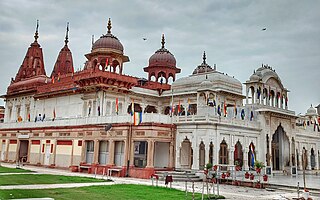
Shri Mahavir Ji is an important and prominent Jain pilgrimage site situated in Shri Mahaveerji town in Hindaun Block, Karauli district in Rajasthan. Given the importance of the religious place, the Indian Railways has specifically developed a railway station under West Central Railway zone by the name of Shri Mahaveerji railway station which is 10 minutes drive from the temple and temple authorities have arranged for regular buses from the station to the temple. The temple is visited by millions of Jain and Hindu devotees every year.
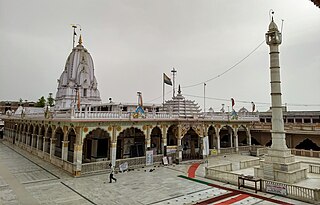
Tijara Jain Temple is a digambar Jain temple dedicated to Chandraprabhu. The temple is located in the hill town Tijara, in the Alwar district of Rajasthan, India. It is an Atishaya Kshetra. It is 55 kilometres (34 mi) from Alwar and 110 kilometres (68 mi) from Delhi. The location is a tirtha for the Jains and a tourist attraction.
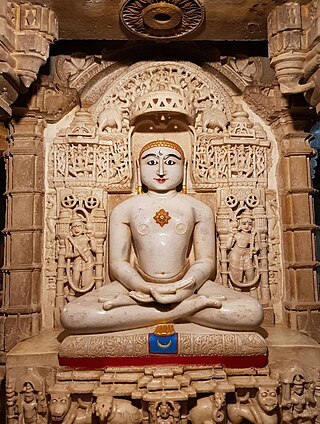
Chandraprabha or Chandranatha is the eighth Tirthankara of Tīrthaṅkara of Jainism in the present age. According to traditional accounts, he was born to King Mahasena and Queen Lakshmana Devi at Chandrapuri to the Ikshvaku dynasty. According to Jain texts, his birth-date was the twelfth day of the Posh Krishna month of the Indian calendar. He is said to have become a siddha, a liberated soul which has destroyed all of its karma.
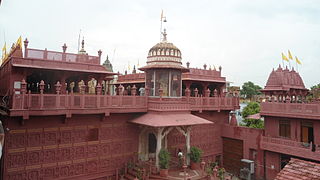
Shri Digamber Jain Atishya Kshetra Mandir, Sanghiji is an ancient Jain Temple in Sanganer, Rajasthan made of red stone. The ancient Shri Digamber Jain temple of Sanganer is 16 km from Jaipur.

Santara or Bhairarasa was a medieval ruling dynasty of Karnataka, India. The area covered by their kingdom included territories in the Malenadu region as well as the coastal districts of Karnataka. Their kingdom had two capitals. Karkala in the coastal plains and Kalasa in the Western ghats. Hence the territory they ruled was also known as the Kalasa-Karkala kingdom. The Santaras were Jains and had matrimonial relations with the Saivite Alupa royal family. The Santaras became the feudatories of the Vijayanagara Empire after its rise. During this period, the Santara ruler Veera Pandya Bhairarasa erected the monolith of Bahubali in Karkala. The dynasty passed into oblivion after invasions by the Nayakas of Keladi and later by Hyder Ali.

The Humcha Jain temples or Humcha basadis are a group of temples found in Humcha village of Shimoga district in Karnataka, India. They were constructed in the 7th century CE in the period of the Santara dynasty and are regarded as one of the major Jain centres of Karnataka. The Padmavati Basadi is the most well-known of these temples.

Parshvanatha Basadi or Kamatha Parshvanatha Basadi is a Jain temple (basadi) located on Chandragiri Hill in Shravanabelagola, a town in Karnataka, India.
















